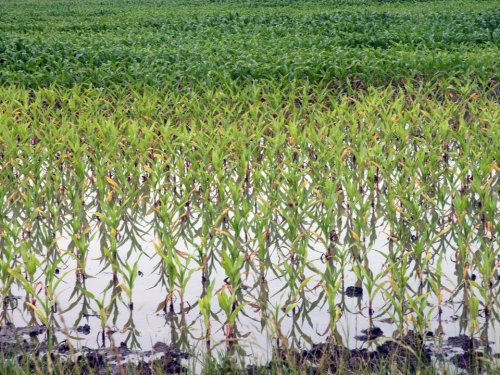
Ponding creates potential for crop damage
Linda Geist
Writer
University of Missouri Extension
May 21, 2020
COLUMBIA, Mo. - Intense or recurrent rainfall creates the potential for damage from ponding, saturated soils and flooding for corn and soybean crops, says University of Missouri Extension agronomist Bill Wiebold.
Some parts of southern Missouri have received 25-30 inches of precipitation since the beginning of the year, says MU Extension climatologist Pat Guinan.
During the first half of May, 3-5 inches of rainfall was common in southern Missouri, with localized higher amounts. May 1-15 precipitation totals were lighter across the northern half of the state, with the most significant rainfall affecting the area on March 14-15, Guinan says.
Survival of submerged corn and soybean seedlings depends on seed quality, how long the flood lasts, water temperatures, how fast fields dry and location of the growing point in the seedling, says Wiebold.
Damage may vary in fields and soil types.
Low-lying areas collect water and "pond," says Wiebold. Ponding may not always be visible. Waterlogging may be under the soil's surface as it reaches field capacity.
Some soil types, such as claypan soils in northeastern Missouri or soils high in clay content, are more prone to waterlogging.
Damage occurs when water aggregates in spaces between soil particles. These spaces should hold air instead of water. This sitting water damages germinating seeds and developing seedlings.
Flooded plants deplete oxygen in the soil in two to four days. Moving water, which allows some life-sustaining oxygen to get to plants, may result in less injury than still water, Wiebold says.
Generally, soybean tolerate flooding better than corn does. In both damaged corn and soybean, expect stand reduction, loss of vigor and lower yield. Root damage impairs the plant's ability to take up water and tolerate drought stress.
Cooler weather improves chances for plant survival. Young plants can survive about two days when temperatures exceed 70 F. They can survive as long as four days when temperatures are in the mid-60s or below.
Survival also depends on how much of the plant is submerged.
Soybean plants possess epigeal emergence, in which the growing point is at the tip of the stem, which elongates above the ground. This may be an advantage because the growing point may remain above the water surface.
Corn plants exhibit hypogeal emergence, so the growing point stays below ground for at least three weeks. In waterlogged soils, that means the center of oxygen need is usually located where it is least available.
Look for new leaf development three to five days after water recedes and examine seedlings for disease. Look for rotted or discolored seedlings and roots, and for damping-off symptoms.
Flooded plants also can face disease pressure. Cool, wet fields create favorable conditions for soil pathogens that delay plant development and growth. This puts some plants at greater risk of soil-borne diseases.
Poor or uneven stands may result from water damage and disease. Wiebold suggests MU Extension publication G4091, "Corn and Soybean Replant Decisions," at extension2.missouri.edu/G4091, for guidance in decision-making.
As soil temperatures rise, MU Extension nutrient management specialist Peter Scharf recommends the Nitrogen Watch page at extension2.missouri.edu/n-watch. The page tracks rainfall and identifies areas that are on track to have problems with nitrogen loss and deficiency in corn.
Image available for this release:

Intense or recurring rainfall creates the potential for ponding in row crops.
Survival of submerged seedlings depends on a number of factors.
Photo credit: Linda Geist
Source: William Wiebold, 573-673-4128 (cell), 573-882-0621












